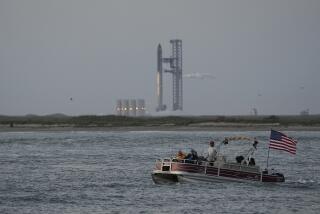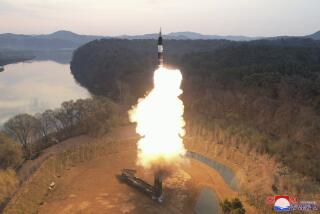Air Force to retest X-51 WaveRider hypersonic aircraft near Point Mugu
The U.S. Air Force plans to launch an experimental aircraft Thursday that could potentially reach speeds of 4,000 mph over the Pacific Ocean in a test flight that could give the Pentagon a new way to deliver a military strike anywhere around the globe within minutes.
Built in Southern California, the unmanned X-51 WaveRider is being developed to deliver powerful warheads at tremendously high speeds with pinpoint accuracy almost anywhere on Earth.
Military officials say the need for the technology became clear in 1998 when the U.S. military tried — and failed — to kill Osama bin Laden. While positioned in the Arabian Sea, Navy vessels lobbed cruise missiles at training camps in Afghanistan, hitting their targets — 80 minutes later. By then, bin Laden was gone.
But with a hypersonic missile, such as the one being tested on the X-51, “the attack would have been cut to just over 12 minutes,” Richard Hallion, a former Air Force senior advisor, said last year in an Air Force Assn. report about hypersonic technology.
While supersonic means that an object is traveling beyond the speed of sound, or Mach 1, “hypersonic” refers to an aircraft blasting through the air at five times that speed or more.
Developing an engine that can reach and maintain those speeds hasn’t been easy. For decades, the development of the hypersonic engine has been fraught with setbacks.
But engineers at Boeing Co.’s Phantom Works research center in Huntington Beach and Pratt & Whitney Rocketdyne in Canoga Park proved they were on the right track last May when the X-51 made its first flight from Edwards Air Force Base.
The 14-foot aircraft was launched midair off the coast near Point Mugu, slung underneath the wing of a B-52 bomber. The WaveRider detached, falling about four seconds before its booster rocket engine ignited and propelled the aircraft to more than 70,000 feet. It then separated from the rocket and sped across the sky, powered by an air-breathing combustion engine, for more than two minutes, reaching about 3,500 mph.
The launch was considered successful because the longest prior hypersonic flight lasted about 10 seconds. But it did not reach the goals the Air Force had set. The military had hoped the plane would reach around 4,000 mph and fly for five minutes. It didn’t because a design flaw forced a shutdown.
Regardless, the flight was “a big deal” to Pentagon officials, said Charlie Brink, the X-51 program manager for the Air Force. The X-51 was built under a $250-million contract, but the government has spent millions more trying to achieve sustained hypersonic flight.
Initially, NASA led the program, fueling speculation that hypersonic engines could help propel spacecraft into orbit. Throughout the 1980s, NASA worked to develop a vehicle that could take off from a runway using jet engines until hypersonic engines kicked in and took it to the edge of space. But the space agency dropped the program because of a lack of funding.
Seeing potential for aircraft and missile systems, the Air Force picked up research on the X-51, which led to its flight last year.
“That flight made believers out of skeptics,” Brink said. “It allowed us to say, ‘If you want to hit objects very quickly and from long distances, here’s an option.’ ”
At the time of the X-51’s first flight, the Pentagon’s intentions for it weren’t widely known. This month, a senior Air Force official revealed the aircraft’s objective.
“In fiscal year 2012, we will begin weaponizing the X-51 research vehicle,” Stephen Walker, the Air Force’s deputy assistant secretary for science, told a congressional panel.
The idea is to quickly deliver a conventional warhead that’s capable of striking a terrorist on the run, a stockpile of chemical weapons or a ballistic missile on its way to being launched.
The X-51 is a forerunner to the military’s hopes for a “prompt global strike” system, which can hit anything on Earth in an hour or less, said John Pike, director of GlobalSecurity.org, a website for military policy research. “They are designed to go faster and farther than anything that’s out there. Technology like this avoids the possibility of getting into a fair fight” with an enemy.
Cruise missiles, such as the Tomahawks launched in Libya last weekend, travel around 550 mph.
But hypersonic missiles are just the beginning of the X-51’s capabilities, said Joe Vogel, an X-51 program manager with Boeing. He foresees the technology being incorporated into spy drones and cargo planes, and even envisions a future in which passenger aircraft are powered by hypersonic engines. “There’s a lot more than the weapon aspect to this technology,” Vogel said.
A hypersonic jet could fly from Los Angeles to New York in a little more than 30 minutes, he predicted.
“This is one of those evolutionary pieces of technology,” Vogel said. “It’s the next step forward in advanced propulsion.”
More to Read
Inside the business of entertainment
The Wide Shot brings you news, analysis and insights on everything from streaming wars to production — and what it all means for the future.
You may occasionally receive promotional content from the Los Angeles Times.









